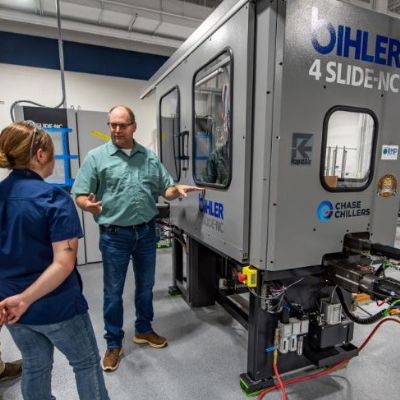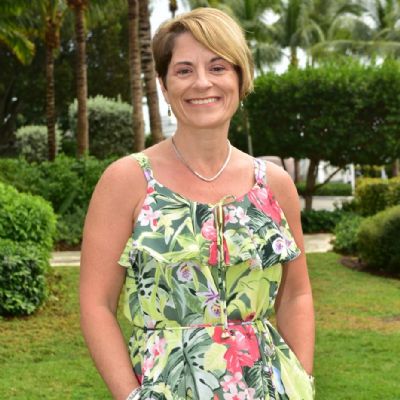Welcome a Dual-Point Bi-Directional Wire Former
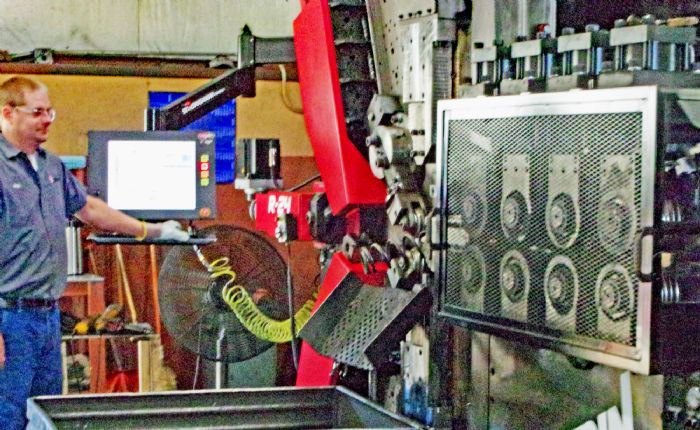 We spoke with Pesaresi shortly after WCS took delivery of its second large-capacity spring coiler, for making its heaviest-duty springs. The machine, an R-24 dual-point spring coiler from Fenn-Torin, resulted from a 15-month collaboration between the two companies, during which time Pesaresi and his team identified numerous custom features required to match the requirements of its customers, and the Fenn-Torin team of engineers were able to oblige.
We spoke with Pesaresi shortly after WCS took delivery of its second large-capacity spring coiler, for making its heaviest-duty springs. The machine, an R-24 dual-point spring coiler from Fenn-Torin, resulted from a 15-month collaboration between the two companies, during which time Pesaresi and his team identified numerous custom features required to match the requirements of its customers, and the Fenn-Torin team of engineers were able to oblige.
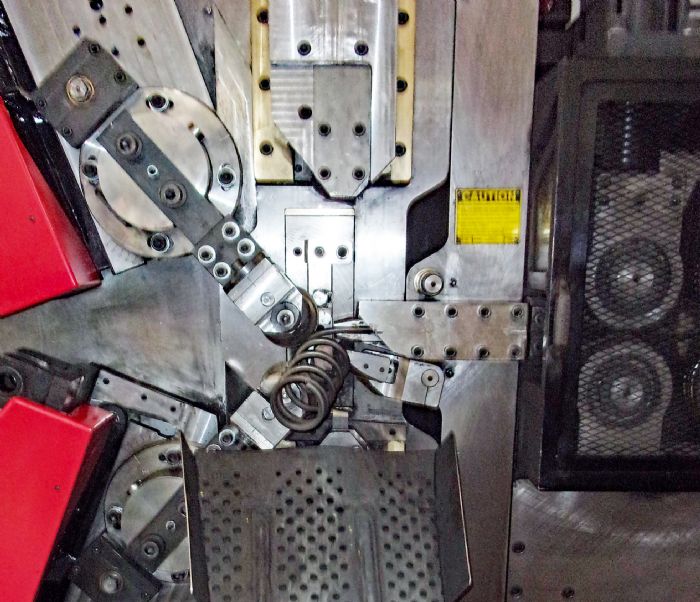 Among the specific and unique features WCS sought: seven servo-motor axes, to handle the complexity of the spring designs customers require; wire-diameter range from 0.250 to 0.625 in.; the ability to change wire sizes without the need for wire-line tooling changes, to reduce setup time; and simple conversion to left and right coiling capability. The new machine features multiple-grooved wire-line tooling and a moveable feed-roll box, with its position able to be stored in the job setup on the machine control (a 19-in. touchscreen). And, it can form more complex helixes requiring both right- and left-hand coiling. Also part of each job recipe: the positions of the moveable cut block and arbor.
Among the specific and unique features WCS sought: seven servo-motor axes, to handle the complexity of the spring designs customers require; wire-diameter range from 0.250 to 0.625 in.; the ability to change wire sizes without the need for wire-line tooling changes, to reduce setup time; and simple conversion to left and right coiling capability. The new machine features multiple-grooved wire-line tooling and a moveable feed-roll box, with its position able to be stored in the job setup on the machine control (a 19-in. touchscreen). And, it can form more complex helixes requiring both right- and left-hand coiling. Also part of each job recipe: the positions of the moveable cut block and arbor.
“Compression springs are our biggest runners,” Pesaresi says, noting that the company now operates eight large-wire machines (including the two newest Fenn-Torin models), and another 35 small and intermediate-sized machines in the coiling department. WCS processes some 16 million lb. of wire/yr., and in addition to coiling also performs numerous secondary operations including end grinding, stress relieving and shot peening.
“Our business was looking to continue the progression of new and improved equipment to meet the changing needs of our customers,” Pesaresi tells MetalForming. “We chose to work with Fenn-Torin on this project because of its willingness to collaborate on design features to meet our specific requirements for a machine of this size.
“We not only seek the right customers for our business, those that share our values, but we look for the same with our suppliers,” Pesaresi adds, reflecting back to the previous R-24 spring coiler the firm purchased from Fenn-Torin 10 years ago. “Especially for a project such as this, a 15-month collaboration, we looked for a machine supplier that would be easy to work with, would provide good communication throughout the build process, and has a can-do attitude committed to providing all of the special features and functions we were looking for.”
Ambidextrous Coiling
“We’re primarily a right-hand coiling company,” Pesaresi says, “so adding the left-hand capability was important to us. Switching over our other machines from right to left takes an hour, or longer, requiring technicians to flip over several heavy mechanical components, and change out valves and linkages—it’s an arduous task. We simply turned away a good deal of that business, or asked customers if they could redesign the springs from a left- to right-hand helix.”
Now, with the new machine it’s simply a matter of calling up the program on the controller and making one linkage adjustment—a 5- to 10-min. process, Pesaresi says.
Why the need for seven servo-controlled machine axes, when other spring coilers have five or six axes?
“We’re regularly asked by customers to produce springs from a variety of ODs and with a range of pitches…we really need that flexibility,” says Pesaresi. “Likewise, with the ability to change wire size without having to change the wire-line tooling, that’s a huge time saver. The machine software allows us to program and store the wire-line settings, so it takes just the push of a button.”
The “Last-But-Not-Least” Feature
…of WCS’ newest heavy-duty spring coiler: online real-time diagnostics, “which provides instant feedback for us from Fenn-Torin engineers, when we need it,” Pesaresi says. “While we’ve only used that capability a few times since we commissioned the machine, the instant connectivity has really streamlined our diagnostic activities when we’ve had issues with the drives and other components.”
WCS’ efforts to continuously improve, through technology, don’t stop with its spring-coiling machines. Just this past September it implemented a new Plex cloud-based ERP system, and Pesaresi also points to the firm’s commitment to automating operations when feasible to not only address skilled-labor issues but to also improve safety, efficiency and quality.
“We’re adding one robot every two years or so,” he says, “not to replace workers but to enhance our efficiency and safety. For those parts that require processing in more than one machine —adding a bend to the end of a coil, for example—we can use a robot to eliminate the painstaking and time-consuming task of batch-processing parts and moving them from machine to machine. Then we retrain any displaced operators and make them ‘robot warriors.’” MF
See also: FENN-Torin Metal Forming
Technologies: Coil and Sheet Handling, Other Processes
 Brad Kuvin
Brad Kuvin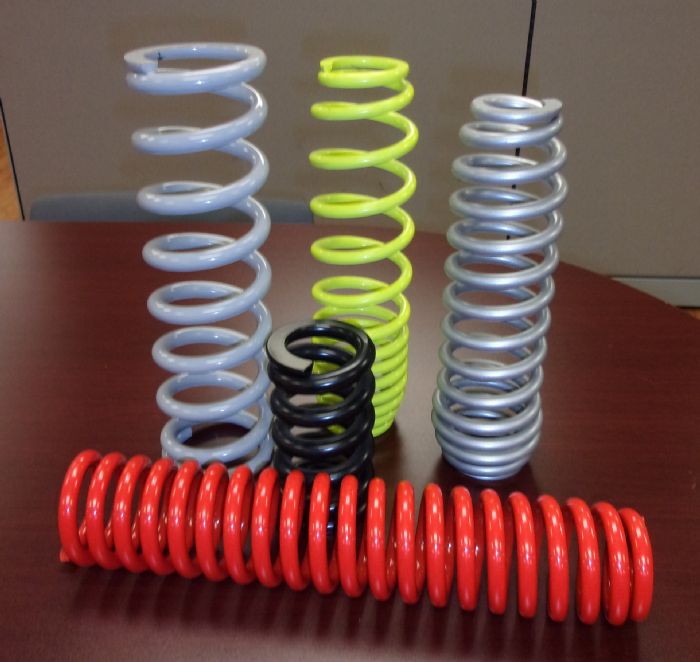 The market for ORVs continues to grow as demand has risen across several sectors, including sports (all-terrain vehicles and snowmobiles), military and hunting activities. The same is true in the agricultural industry, with compression springs mounted all over vehicle suspensions to handle axially applied compressive forces, and on farm implements to battle repetitive motion and support heavy loads.
The market for ORVs continues to grow as demand has risen across several sectors, including sports (all-terrain vehicles and snowmobiles), military and hunting activities. The same is true in the agricultural industry, with compression springs mounted all over vehicle suspensions to handle axially applied compressive forces, and on farm implements to battle repetitive motion and support heavy loads. 





 We spoke with Pesaresi shortly after WCS took delivery of its second large-capacity spring coiler, for making its heaviest-duty springs. The machine, an R-24 dual-point spring coiler from Fenn-Torin, resulted from a 15-month collaboration between the two companies, during which time Pesaresi and his team identified numerous custom features required to match the requirements of its customers, and the Fenn-Torin team of engineers were able to oblige.
We spoke with Pesaresi shortly after WCS took delivery of its second large-capacity spring coiler, for making its heaviest-duty springs. The machine, an R-24 dual-point spring coiler from Fenn-Torin, resulted from a 15-month collaboration between the two companies, during which time Pesaresi and his team identified numerous custom features required to match the requirements of its customers, and the Fenn-Torin team of engineers were able to oblige. Among the specific and unique features WCS sought: seven servo-motor axes, to handle the complexity of the spring designs customers require; wire-diameter range from 0.250 to 0.625 in.; the ability to change wire sizes without the need for wire-line tooling changes, to reduce setup time; and simple conversion to left and right coiling capability. The new machine features multiple-grooved wire-line tooling and a moveable feed-roll box, with its position able to be stored in the job setup on the machine control (a 19-in. touchscreen). And, it can form more complex helixes requiring both right- and left-hand coiling. Also part of each job recipe: the positions of the moveable cut block and arbor.
Among the specific and unique features WCS sought: seven servo-motor axes, to handle the complexity of the spring designs customers require; wire-diameter range from 0.250 to 0.625 in.; the ability to change wire sizes without the need for wire-line tooling changes, to reduce setup time; and simple conversion to left and right coiling capability. The new machine features multiple-grooved wire-line tooling and a moveable feed-roll box, with its position able to be stored in the job setup on the machine control (a 19-in. touchscreen). And, it can form more complex helixes requiring both right- and left-hand coiling. Also part of each job recipe: the positions of the moveable cut block and arbor.